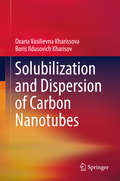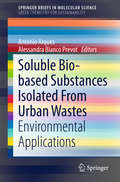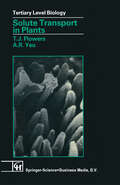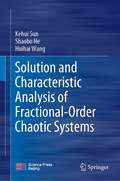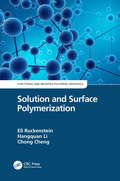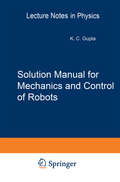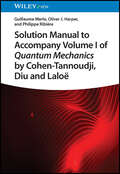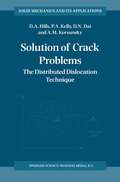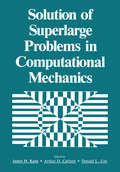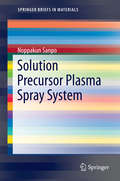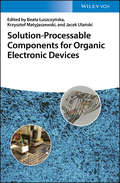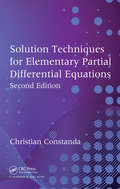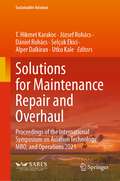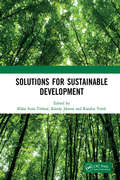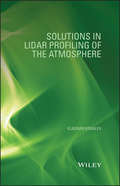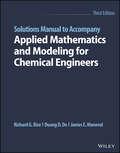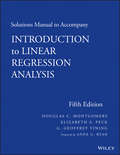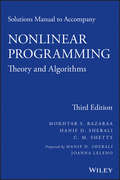- Table View
- List View
Solubilization and Dispersion of Carbon Nanotubes
by Oxana Vasilievna Kharissova Boris Ildusovich KharisovThis book describes a series of contemporary techniques and their combinations used for CNTs solubilization, from physical to chemical and biological, applying inorganic and organic compounds, as well as some metal complexes. In some cases, successive steps can be applied, for instance the use of low and high-weight surfactants, or mineral acid treatment for creation of –OH and –COOH groups and their further interaction with organic molecules. Each discussed method leads to an improvement of CNT solubility, frequently a considerable one. The formed dispersions can be stable for long periods of time, from several weeks to some months, and they sometimes even remain stable after centrifugation. Several special studies have been carried out in the areas of influence of solvent and light on CNTs dispersibility, combinations and abilities of surfactants, CNT cytotoxicity, etc. Applications of solubilized CNTs are discussed in this book as well.
Soluble Bio-based Substances Isolated From Urban Wastes: Environmental Applications (SpringerBriefs in Molecular Science)
by Antonio Arques Alessandra Bianco PrevotThis brief gives a summary of the soluble bio-based substances (SBO) field. Urban bio-wastes of differing compositions and ageing conditions represent a promising source of soluble bio-based substances (SBO), potentially able to perform as chemical auxiliaries for applications in the chemical industry and in environmental remediation. In particular, SBO process development, characterization and scale-up is described and bioassay studies discussed. This brief also discusses the use of SBOs in wastewater treatment in the context of 'green' processes, their role as humic-like substances, and their potential use as photocatalysts for the degradation of pollutants present in aqueous solutions (dyes, pharmaceuticals, chlorophenols). Furthermore, the role of SBOs as complexing agents for iron ions in the implementation of the photo-Fenton processes under mild pH conditions is also explored. Finally, SBOs are showcased in their capacity as organic component alternatives to petrochemical products for the synthesis of new materials.
Solute Transport in Plants (Tertiary Level Biology Ser.)
by T.J. Flowers A.R. YeoThe study of solute transport in plants dates back to the beginnings of experimental plant physiology, but has its origins in the much earlier interests of humankind in agriculture. Given this lineage, it is not surprising that there have been many books on the transport of solutes in plants; texts on the closely related subject of mineral nutrition also commonly address the topic of ion transport. Why another book? Well, physiologists continue to make new discoveries. Particularly pertinent is the characterisation of enzymes that are able to transport protons across membranes during the hydrolysis of energy-rich bonds. These enzymes, which include the H + -A TPases, are now known to be crucial for solute transport in plants and we have given them due emphasis. From an academic point of view, the transport systems in plants are now appreciated as worthy of study in their own right-not just as an extension of those systems already much more widely investigated in animals. From a wider perspective, understanding solute transport in plants is fundamental to understanding plants and the extent to which they can be manipulated for agricultural purposes. As physiologists interested in the mechanisms of transport, we first set out in this book to examine the solutes in plants and where are they located. Our next consideration was to provide the tools by which solute movement can be understood: a vital part of this was to describe membranes and those enzymes catalysing transport.
Solution and Characteristic Analysis of Fractional-Order Chaotic Systems
by Kehui Sun Shaobo He Huihai WangThis book highlights the solution algorithms and characteristic analysis methods of fractional-order chaotic systems. Fractal dimensions exist broadly in the study of nature and the development of science and technology. Fractional calculus has become a hot research area in nonlinear science. Fractional-order chaotic systems are an important part of fractional calculus. The book discusses the numerical solution algorithms and characteristic analysis of fractional-order chaotic systems and introduces the techniques to implement the systems with circuits. To facilitate a quick grasp, the authors present examples from their years of work in the appendix. Intended for graduate students and researchers interested in chaotic systems, the book helps one to build a theoretical and experimental foundation for the application of fractional-order chaotic systems.
Solution and Surface Polymerization
by Eli Ruckenstein, Hangquan Li and Chong ChengComprising one volume of Functional and Modified Polymeric Materials, Two-Volume Set, this well-organized collection of papers by Professor Eli Ruckenstein and co-workers focuses on functional and modified polymeric materials prepared mainly through solution polymerization and surface polymerization. Although solution polymerization has been broadly utilized for the preparation of polymeric materials, the book shows significant approaches to special classes of polymeric materials including functional polymers by living ionic polymerization, degradable and decrosslinkable polymers, semi- and interpenetrating polymer network pervaporation membranes, and soluble conducting polymers. It also focuses on preparing and modifying conductive surface of polymer or polymer-based materials.
Solution and Surface Polymerization
by Eli Ruckenstein Hangquan Li Chong ChengComprising one volume of Functional and Modified Polymeric Materials, Two-Volume Set, this well-organized collection of papers by Professor Eli Ruckenstein and co-workers focuses on functional and modified polymeric materials prepared mainly through solution polymerization and surface polymerization. Although solution polymerization has been broadly utilized for the preparation of polymeric materials, the book shows significant approaches to special classes of polymeric materials including functional polymers by living ionic polymerization, degradable and decrosslinkable polymers, semi- and interpenetrating polymer network pervaporation membranes, and soluble conducting polymers. It also focuses on preparing and modifying conductive surface of polymer or polymer-based materials.
Solution Manual for Mechanics and Control of Robots: Springer, 1997 (Mechanical Engineering Series)
by Krishna C. GuptaIntended as an introduction to robot mechanics for students of mechanical, industrial, electrical, and bio-mechanical engineering, this graduate text presents a wide range of approaches and topics. It avoids formalism and proofs but nonetheless discusses advanced concepts and contemporary applications. It will thus also be of interest to practicing engineers. The book begins with kinematics, emphasizing an approach based on rigid-body displacements instead of coordinate transformations; it then turns to inverse kinematic analysis, presenting the widely used Pieper-Roth and zero-reference-position methods. This is followed by a discussion of workplace characterization and determination. One focus of the discussion is the motion made possible by sperical and other novel wrist designs. The text concludes with a brief discussion of dynamics and control. An extensive bibliography provides access to the current literature.
Solution Manual to Accompany Volume I of Quantum Mechanics by Cohen-Tannoudji, Diu and Laloë
by Guillaume Merle Oliver J. Harper Philippe RibiereSolution Manual to Accompany Volume I of Quantum Mechanics by Cohen-Tannoudji, Diu and Laloë Grasp the fundamentals of quantum mechanics with this essential set of solutions Quantum mechanics, with its counter-intuitive premises and its radical variations from classical mechanics or electrodynamics, is both among the most important components of a modern physics education and one of the most challenging. It demands both a theoretical grounding and a grasp of mathematical technique that take time and effort to master. Students working through quantum mechanics curricula generally practice by working through increasingly difficult problem sets, such as those found in the seminal Quantum Mechanics volumes by Cohen-Tannoudji, Diu and Laloë. This solution manual accompanies Volume I and offers the long-awaited detailed solutions to all 69 problems in this text. Its accessible format provides explicit explanations of every step, focusing on both the physical theory and the formal mathematics, to ensure students grasp all pertinent concepts. It also includes guidance for transferring the solution approaches to comparable problems in quantum mechanics. Readers also benefit from: Approximately 70 figures to clarify key steps and concepts Detailed explanations of problems concerning quantum mechanics postulates, mathematical tools, properties of angular momentum, and more This solution manual is a must-have for students in physics, chemistry, or the materials sciences looking to master these challenging problems, as well as for instructors looking for pedagogical approaches to the subject.
Solution Manual to Accompany Volume I of Quantum Mechanics by Cohen-Tannoudji, Diu and Laloë
by Guillaume Merle Oliver J. Harper Philippe RibiereSolution Manual to Accompany Volume I of Quantum Mechanics by Cohen-Tannoudji, Diu and Laloë Grasp the fundamentals of quantum mechanics with this essential set of solutions Quantum mechanics, with its counter-intuitive premises and its radical variations from classical mechanics or electrodynamics, is both among the most important components of a modern physics education and one of the most challenging. It demands both a theoretical grounding and a grasp of mathematical technique that take time and effort to master. Students working through quantum mechanics curricula generally practice by working through increasingly difficult problem sets, such as those found in the seminal Quantum Mechanics volumes by Cohen-Tannoudji, Diu and Laloë. This solution manual accompanies Volume I and offers the long-awaited detailed solutions to all 69 problems in this text. Its accessible format provides explicit explanations of every step, focusing on both the physical theory and the formal mathematics, to ensure students grasp all pertinent concepts. It also includes guidance for transferring the solution approaches to comparable problems in quantum mechanics. Readers also benefit from: Approximately 70 figures to clarify key steps and concepts Detailed explanations of problems concerning quantum mechanics postulates, mathematical tools, properties of angular momentum, and more This solution manual is a must-have for students in physics, chemistry, or the materials sciences looking to master these challenging problems, as well as for instructors looking for pedagogical approaches to the subject.
Solution of Crack Problems: The Distributed Dislocation Technique (Solid Mechanics and Its Applications #44)
by D.A. Hills P.A. Kelly D.N. Dai A.M. KorsunskyThis book is concerned with the numerical solution of crack problems. The techniques to be developed are particularly appropriate when cracks are relatively short, and are growing in the neighbourhood of some stress raising feature, causing a relatively steep stress gradient. It is therefore practicable to represent the geometry in an idealised way, so that a precise solution may be obtained. This contrasts with, say, the finite element method in which the geometry is modelled exactly, but the subsequent solution is approximate, and computationally more taxing. The family of techniques presented in this book, based loosely on the pioneering work of Eshelby in the late 1950's, and developed by Erdogan, Keer, Mura and many others cited in the text, present an attractive alternative. The basic idea is to use the superposition of the stress field present in the unfiawed body, together with an unknown distribution of 'strain nuclei' (in this book, the strain nucleus employed is the dislocation), chosen so that the crack faces become traction-free. The solution used for the stress field for the nucleus is chosen so that other boundary conditions are satisfied. The technique is therefore efficient, and may be used to model the evolution of a developing crack in two or three dimensions. Solution techniques are described in some detail, and the book should be readily accessible to most engineers, whilst preserving the rigour demanded by the researcher who wishes to develop the method itself.
Solution of Superlarge Problems in Computational Mechanics
by James H. KaneThere is a need to solve problems in solid and fluid mechanics that currently exceed the resources of current and foreseeable supercomputers. The issue revolves around the number of degrees of freedom of simultaneous equations that one needs to accurately describe the problem, and the computer storage and speed limitations which prohibit such solutions. The goals of tHis symposium were to explore some of the latest work being done in both industry and academia to solve such extremely large problems, and to provide a forum for the discussion and prognostication of necessary future direc tions of both man and machine. As evidenced in this proceedings we believe these goals were met. Contained in this volume are discussions of: iterative solvers, and their application to a variety of problems, e.g. structures, fluid dynamics, and structural acoustics; iterative dynamic substructuring and its use in structural acoustics; the use of the boundary element method both alone and in conjunction with the finite element method; the application of finite difference methods to problems of incompressible, turbulent flow; and algorithms amenable to concurrent computations and their applications. Furthermore, discussions of existing computational shortcomings from the big picture point of view are presented that include recommendations for future work.
Solution Precursor Plasma Spray System (SpringerBriefs in Materials)
by Noppakun SanpoThis Brief describes the influence of the different organic chelating agents on the topography, physical properties and phases of SPPS-deposited spinel ferrite splats. The author describes how by using the SPPS process, the coating is produced directly from a solution precursor and how all physical and chemical reactions such as evaporation, decomposition, crystallization and coating formation occur in a single step. The author details not only the innovative approach to liquid feeding, but also focuses on its effects on the spinel ferrite system. The results of experimentation as well as detailed explanations of the experiments are included.
Solution-Processable Components for Organic Electronic Devices
by Krzysztof Matyjaszewski Beata Łuszczyńska Jacek UlańskiProvides first-hand insights into advanced fabrication techniques for solution processable organic electronics materials and devices The field of printable organic electronics has emerged as a technology which plays a major role in materials science research and development. Printable organic electronics soon compete with, and for specific applications can even outpace, conventional semiconductor devices in terms of performance, cost, and versatility. Printing techniques allow for large-scale fabrication of organic electronic components and functional devices for use as wearable electronics, health-care sensors, Internet of Things, monitoring of environment pollution and many others, yet-to-be-conceived applications. The first part of Solution-Processable Components for Organic Electronic Devices covers the synthesis of: soluble conjugated polymers; solution-processable nanoparticles of inorganic semiconductors; high-k nanoparticles by means of controlled radical polymerization; advanced blending techniques yielding novel materials with extraordinary properties. The book also discusses photogeneration of charge carriers in nanostructured bulk heterojunctions and charge carrier transport in multicomponent materials such as composites and nanocomposites as well as photovoltaic devices modelling. The second part of the book is devoted to organic electronic devices, such as field effect transistors, light emitting diodes, photovoltaics, photodiodes and electronic memory devices which can be produced by solution-based methods, including printing and roll-to-roll manufacturing. The book provides in-depth knowledge for experienced researchers and for those entering the field. It comprises 12 chapters focused on: ? novel organic electronics components synthesis and solution-based processing techniques ? advanced analysis of mechanisms governing charge carrier generation and transport in organic semiconductors and devices ? fabrication techniques and characterization methods of organic electronic devices Providing coverage of the state of the art of organic electronics, Solution-Processable Components for Organic Electronic Devices is an excellent book for materials scientists, applied physicists, engineering scientists, and those working in the electronics industry.
Solution-Processable Components for Organic Electronic Devices
Provides first-hand insights into advanced fabrication techniques for solution processable organic electronics materials and devices The field of printable organic electronics has emerged as a technology which plays a major role in materials science research and development. Printable organic electronics soon compete with, and for specific applications can even outpace, conventional semiconductor devices in terms of performance, cost, and versatility. Printing techniques allow for large-scale fabrication of organic electronic components and functional devices for use as wearable electronics, health-care sensors, Internet of Things, monitoring of environment pollution and many others, yet-to-be-conceived applications. The first part of Solution-Processable Components for Organic Electronic Devices covers the synthesis of: soluble conjugated polymers; solution-processable nanoparticles of inorganic semiconductors; high-k nanoparticles by means of controlled radical polymerization; advanced blending techniques yielding novel materials with extraordinary properties. The book also discusses photogeneration of charge carriers in nanostructured bulk heterojunctions and charge carrier transport in multicomponent materials such as composites and nanocomposites as well as photovoltaic devices modelling. The second part of the book is devoted to organic electronic devices, such as field effect transistors, light emitting diodes, photovoltaics, photodiodes and electronic memory devices which can be produced by solution-based methods, including printing and roll-to-roll manufacturing. The book provides in-depth knowledge for experienced researchers and for those entering the field. It comprises 12 chapters focused on: ? novel organic electronics components synthesis and solution-based processing techniques ? advanced analysis of mechanisms governing charge carrier generation and transport in organic semiconductors and devices ? fabrication techniques and characterization methods of organic electronic devices Providing coverage of the state of the art of organic electronics, Solution-Processable Components for Organic Electronic Devices is an excellent book for materials scientists, applied physicists, engineering scientists, and those working in the electronics industry.
Solution Techniques for Elementary Partial Differential Equations
by Christian ConstandaIncorporating a number of enhancements, Solution Techniques for Elementary Partial Differential Equations, Second Edition presents some of the most important and widely used methods for solving partial differential equations (PDEs). The techniques covered include separation of variables, method of characteristics, eigenfunction expansion, Fourier a
Solutions for Maintenance Repair and Overhaul: Proceedings of the International Symposium on Aviation Technology, MRO, and Operations 2021 (Sustainable Aviation)
by T. Hikmet Karakoc József Rohács Dániel Rohács Selçuk Ekici Alper Dalkiran Utku KaleThe International Symposium on Aircraft Technology, MRO, and Operations (ISATECH) is a multi-disciplinary symposium that presents research on current issues in the field of aerospace. The conference provides a platform offering insights on the latest trends in aircraft technology, maintenance, repair, overhaul, and operations that offer innovative solutions to the challenges facing the aviation industry. ISATECH allows researchers, scientists, engineers, practitioners, policymakers, and students to exchange information, present new technologies and developments, and discuss future direction, strategies and priorities.
Solutions for Sustainable Development: Proceedings of the 1st International Conference on Engineering Solutions for Sustainable Development (ICESSD 2019), October 3-4, 2019, Miskolc, Hungary
by Klára Szita Tóthné Károly Jármai Katalin VoithThe first International Conference on Engineering Solutions and Sustainable Development which is organized by the University of Miskolc, Hungary is a significant and timely initiative creating the capacity of engineering students, educators, practicing engineers and industries to demonstrate values, problem solving skills, knowledge, and attitude that are required to apply the principles of sustainable development throughout their professional career.The aim of the ICESSD conference was creating an interdisciplinary platform for researchers and practitioners to present and discuss the most recent innovations, trends, and concerns as well as practical challenges encountered and solutions adopted in the fields of Technical and Environmental Science. The conference covers the following topics: Process Engineering, Modelling and Optimisation Sustainable and Renewable Energy and Energy Engineering Waste Management and Reverse Logistics Environmental Management and Ecodesign Circular Economy and Life Cycle Approaches Smart Manufacturing and Smart Buildings Innovation and Efficiency Earth Science Academics, scientists, researchers and professionals from different countries and continents have contributed to this book.
Solutions in LIDAR Profiling of the Atmosphere
by Vladimir A. KovalevProvides tools and techniques to identify and address distortions and to interpret data coming from Lidar sensing technology This book covers the issues encountered in separating the backscatter and transmission terms in the LIDAR equation when profiling the atmosphere with zenith-directed and vertically-scanning Lidars. Solutions in Lidar Profiling of the Atmosphere explains how to manage and interpret the Llidar signals when the uncertainties of the involved atmospheric parameters are not treatable statistically. The author discusses specific scenarios for using specific scenarios for profiling vertical aerosol loading. Solutions in Lidar Profiling of the Atmosphere emphasizes the use of common sense when interacting with potentially large distortions inherent in most inversion techniques. Addresses the systematic errors in LIDAR measurements Proposes specific methods to estimate systematic distortions Explains how to apply these methods to both simulated and real data Solutions in Lidar Profiling of the Atmosphere is written for scientists, researchers, and graduate students in Meteorology and Geophysics.
Solutions in LIDAR Profiling of the Atmosphere
by Vladimir A. KovalevProvides tools and techniques to identify and address distortions and to interpret data coming from Lidar sensing technology This book covers the issues encountered in separating the backscatter and transmission terms in the LIDAR equation when profiling the atmosphere with zenith-directed and vertically-scanning Lidars. Solutions in Lidar Profiling of the Atmosphere explains how to manage and interpret the Llidar signals when the uncertainties of the involved atmospheric parameters are not treatable statistically. The author discusses specific scenarios for using specific scenarios for profiling vertical aerosol loading. Solutions in Lidar Profiling of the Atmosphere emphasizes the use of common sense when interacting with potentially large distortions inherent in most inversion techniques. Addresses the systematic errors in LIDAR measurements Proposes specific methods to estimate systematic distortions Explains how to apply these methods to both simulated and real data Solutions in Lidar Profiling of the Atmosphere is written for scientists, researchers, and graduate students in Meteorology and Geophysics.
Solutions Manual to Accompany Applied Mathematics and Modeling for Chemical Engineers
by Richard G. Rice Duong D. Do James E. ManevalThis book is a Solutions Manual to accompany Applied Mathematics and Modeling for Chemical Engineers, Third Edition. There are many examples provided as homework in the original text and the solution manual provides detailed solutions of many of these problems that are in the parent book Applied Mathematics and Modeling for Chemical Engineers, Third Edition.
Solutions Manual to Accompany Applied Mathematics and Modeling for Chemical Engineers
by Richard G. Rice Duong D. Do James E. ManevalThis book is a Solutions Manual to accompany Applied Mathematics and Modeling for Chemical Engineers, Third Edition. There are many examples provided as homework in the original text and the solution manual provides detailed solutions of many of these problems that are in the parent book Applied Mathematics and Modeling for Chemical Engineers, Third Edition.
Solutions Manual to accompany Introduction to Linear Regression Analysis (Wiley Series In Probability And Statistics Ser. #821)
by Douglas C. Montgomery Elizabeth A. Peck G. Geoffrey ViningAs the Solutions Manual, this book is meant to accompany the main title, Introduction to Linear Regression Analysis, Fifth Edition. Clearly balancing theory with applications, this book describes both the conventional and less common uses of linear regression in the practical context of today's mathematical and scientific research. Beginning with a general introduction to regression modeling, including typical applications, the book then outlines a host of technical tools that form the linear regression analytical arsenal, including: basic inference procedures and introductory aspects of model adequacy checking; how transformations and weighted least squares can be used to resolve problems of model inadequacy; how to deal with influential observations; and polynomial regression models and their variations. The book also includes material on regression models with autocorrelated errors, bootstrapping regression estimates, classification and regression trees, and regression model validation.
Solutions Manual to accompany Introduction to Linear Regression Analysis
by Douglas C. Montgomery Elizabeth A. Peck G. Geoffrey ViningAs the Solutions Manual, this book is meant to accompany the main title, Introduction to Linear Regression Analysis, Fifth Edition. Clearly balancing theory with applications, this book describes both the conventional and less common uses of linear regression in the practical context of today's mathematical and scientific research. Beginning with a general introduction to regression modeling, including typical applications, the book then outlines a host of technical tools that form the linear regression analytical arsenal, including: basic inference procedures and introductory aspects of model adequacy checking; how transformations and weighted least squares can be used to resolve problems of model inadequacy; how to deal with influential observations; and polynomial regression models and their variations. The book also includes material on regression models with autocorrelated errors, bootstrapping regression estimates, classification and regression trees, and regression model validation.
Solutions Manual to accompany Nonlinear Programming: Theory and Algorithms
by Mokhtar S. Bazaraa Hanif D. Sherali C. M. ShettyAs the Solutions Manual, this book is meant to accompany the main title, Nonlinear Programming: Theory and Algorithms, Third Edition. This book presents recent developments of key topics in nonlinear programming (NLP) using a logical and self-contained format. The volume is divided into three sections: convex analysis, optimality conditions, and dual computational techniques. Precise statements of algortihms are given along with convergence analysis. Each chapter contains detailed numerical examples, graphical illustrations, and numerous exercises to aid readers in understanding the concepts and methods discussed.
Solutions Manual to accompany Nonlinear Programming: Theory and Algorithms
by Mokhtar S. Bazaraa Hanif D. Sherali C. M. ShettyAs the Solutions Manual, this book is meant to accompany the main title, Nonlinear Programming: Theory and Algorithms, Third Edition. This book presents recent developments of key topics in nonlinear programming (NLP) using a logical and self-contained format. The volume is divided into three sections: convex analysis, optimality conditions, and dual computational techniques. Precise statements of algortihms are given along with convergence analysis. Each chapter contains detailed numerical examples, graphical illustrations, and numerous exercises to aid readers in understanding the concepts and methods discussed.
